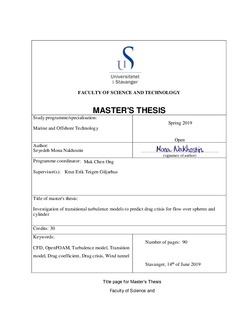| dc.description.abstract | The current work performed experimental and numerical studies of flow over cylinders and spheres. The purpose is to investigate whether the drag crisis phenomenon can be predicted, and to gain insight into the transition from laminar to turbulent flow in the boundary layer.
An experiment was performed in a wind tunnel for flow over the sphere. The experiment has been performed on a sphere with smooth surface, and also with a trip wire at various locations on the surface. The results have shown that the placement of the trip wire on the surface changes the drag behavior significantly. Unfortunately the rod which was used in order to hold the sphere in the wind tunnel caused some unwanted changes in the wake area. Therefore, most of the simulations have been done on the sphere and cylinder in the free stream, and the results compared well to other experiments from the scientific literature.
The simulations have been done for several Reynolds numbers covering the laminar and transitional flow regimes in the boundary layer. The turbulence models used were RANS with k-ω SST and DES with k-ω SST as RANS model. For transition modelling, the Langtry-Menter model was used. Simulations for the cylinder have been performed for three Reynolds numbers, 3900, 10 000 and 50 000 in both models. For the sphere, seven cases has been defined with different Reynolds numbers, 〖10〗^4, 4×〖10〗^4, 〖10〗^5, 2×〖10〗^5, 2.5×〖10〗^5, 5×〖10〗^5 and 〖10〗^6, and were simulated with both models.
For the cylinder, the computed drag coefficients were in a good agreement with experimental results at the lower Reynolds number. At the higher Reynolds numbers in the transition region, the computed results with transitional model were closer to experimental results compared to the fully turbulent model.
In the sphere case, there was also good agreement with experimental results at subcritical Reynolds numbers. Also, at supercritical Reynolds numbers, the fully turbulent model performs well. In the transition region, the transition model gives higher drag than the fully turbulent, and the results are closer to the experimental results. However, some numerical instabilities were also observed at the highest Reynolds numbers. | nb_NO |

